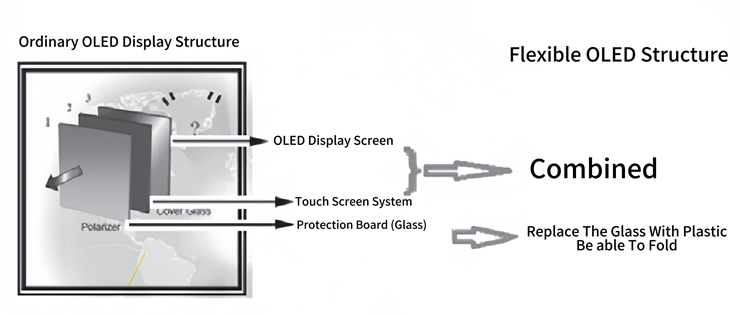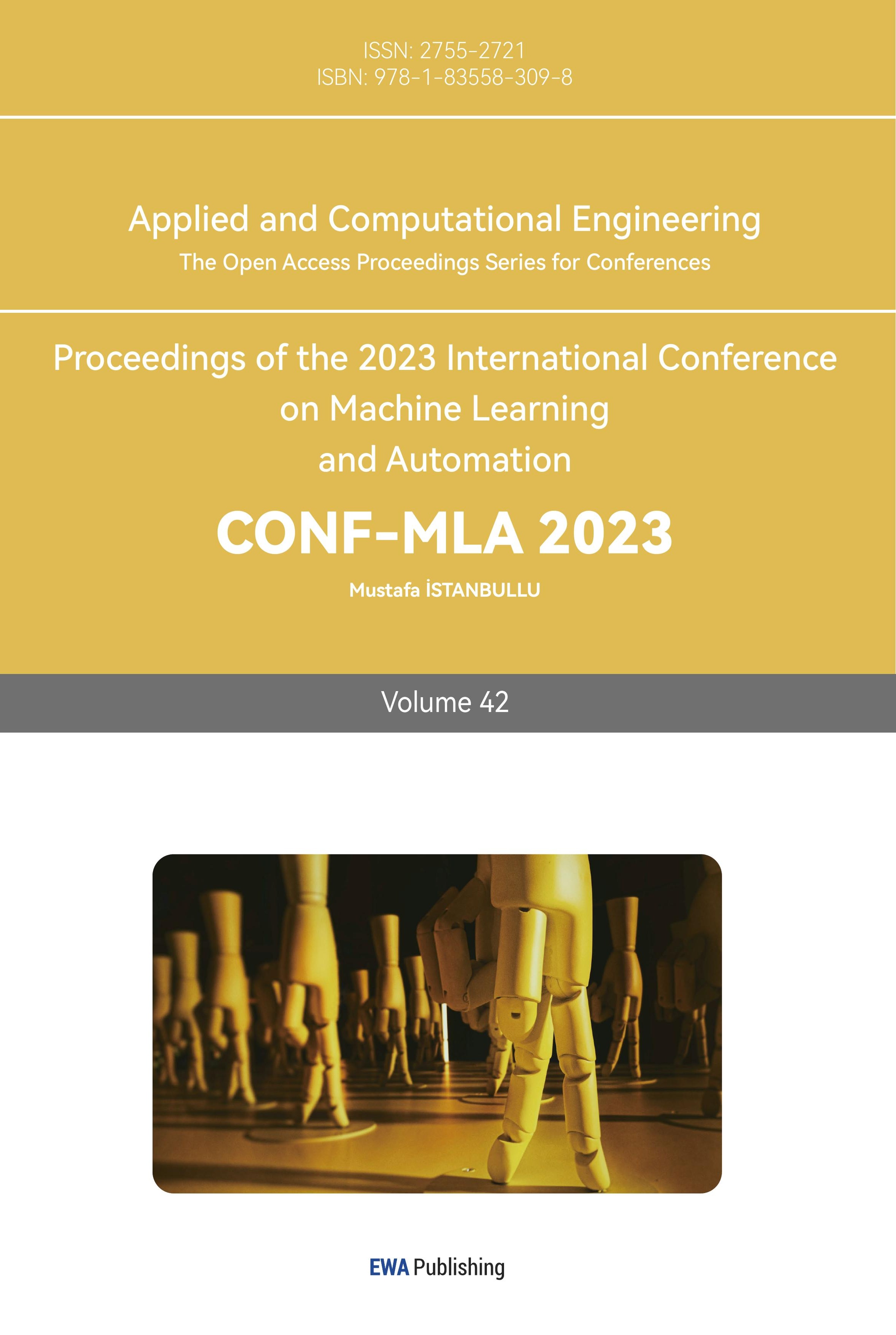1. Introduction
With the development of screen display technology, flexible OLED, as an important part of the development trend, has immeasurable development prospects. Flexible screen is in great demand in all aspects of life and wide application scenarios because of their lightness, portability and wearability (as shown in Figure 1). However, the flexible screen still has many defects that cannot be ignored, which need to be developed and improved. Therefore, it is necessary to master the principle of flexible display and analyze its advantages and disadvantages in depth to predict the future development trend of flexible display technology. In this paper, the foundation, development history, advantages and disadvantages, application prospect and future trend of flexible OLED are explained in detail.

Figure 1. Different modes of flexible display system in life [1].
2. Overviews of the flexible screen and its folding principle
Flexible screen, as the name suggests, is a non-rigid, foldable display screen. Flexible displays are active matrix organic light-emitting diode panels, which are regarded as the primary stage of the display revolution, and the wearability and mobility of electronic devices as the ultimate goal. The progress of the flexible characteristics of the screen comes from the improvement of the adhesion material. Flexible OLED uses flexible electronic components and organic materials to create a display panel on a substrate. For the substrate, the structure of ordinary OLED is generally composed of three parts: OLED display screen, touch screen system and external glass protection plate. Because the OLED display itself is made of soft materials, the display itself is flexible. And the flexible OLED uses a large, thick plastic as the substrate raw material, replacing the hard glass. With the help of film packaging technology, so that the flexible display is attached to the plastic this deformable material. In addition, the application of flexible electronics is also an important part of the realization of screen flexibility. Commonly used electronic components include organic semiconductors, flexible electrodes, etc., and flexible materials include polyimide films, polyamide films, polyethylene films, etc. The principle of flexible display can be simply summarized as: by making electronic components on flexible materials, and connecting them with the circuit board, and then making the entire screen into a flexible form. The flexible display can be bent, rolled or folded without affecting the display effect of the screen and the normal operation of the electronic components.
3. The development history and application examples of flexible screen
The origin of flexible display technology can be traced back to the early 1990s, when flexible electronic technology based on polymer liquid crystal, organic light emitting diode (OLED), thin film transistor and flexible substrate technology has been initially applied to flexible sensors, flexible displays and flexible batteries. With the change of times and the continuous progress of technology, flexible display technology has been rapidly developed. The commercialization of active-matrix OLED (AMOLED) display products is accelerating [2,3]. In 2005, Samsung developed the first flexible organic light-emitting diode (OLED) display, marking the stage of industrial production of flexible display technology. Since then, OLED technology has made great progress, and the application field has been expanded. In 2010, Samsung released its first foldable OLED phone, the Galaxy Fold, which caused a stir in the market. In 2018, LG Display showed off a flexible OLED screen and began selling it to the market. From 2005 to the present, flexible display technology has achieved remarkable results after more than ten years of exploration and development [4]. From the first generation of rigid OLED, to the second generation of bendable OLED, and then to the third generation of foldable and rollable OLED, OLED screens are constantly upgrading and iterating, and the flexible screen will lead the tide of display technology in the future. According to Verified Market Research’s “Foldable Display Market” research, the worldwide foldable display market was estimated at USD255.5 million in 2020. It is expected to reach USD7773.04 million by 2028, with a CAGR of 53.3% between 2021 and 2028 [5].
4. Advantages and challenges of flexible screen
4.1. Advantages of flexible screen
What kind of impact will flexible screens bring to our lives?
1. The existence of flexible display technology provides us with wearable devices that can be fitted closely. Because the various parts of the human body are irregular shapes, rather than flat planes like walls, flexible technology is very important for the fit of wearable devices. A long time ago, because the screen could not be bent, the manufacture of wearable devices could not be tightly fitted to the human body. Now, with the popularity of wearable devices, flexible screens can give users a better experience. For example, wearable wrist devices made of flexible screens can better contact with our wrists. It has more diverse application scenarios.
Flexible screens are not just flexible.
2. Flexible screens make our phones more fall-resistant. In daily life, there are countless examples of accidentally dropping your phone to the ground and causing screen damage. This is because the outside of the regular mobile phone screen is attached to a layer of protective glass that is tightly integrated with the touch screen, which is easily broken when the mobile phone is dropped from a height. The flexible screen mostly uses plastic material, and the weight is lighter, so this plastic material can play a certain buffer protection role when the flexible mobile phone falls, to avoid screen damage. In fact, the fall resistance is the biggest practical point of the flexible screen, which is why some big manufacturers like Samsung and Huawei focus on the development of flexible technology.
3. Flexible screens allow us to use thinner phones. The thin and light mobile phone screen is the mainstream direction of current development. OLEDs are the most promising candidate as a new alternative to LCDs due to their near-perfect viewing angle, fast response, high contrast ratio, thin structure and lightweight [6]. Traditional LCD is mainly composed of LCD display screen, backlight group, touch screen system, filter plate and external protective glass. The structure of OLED is relatively simple, in contrast, it has fewer backlight groups and filters, so OLED can be inherently lighter and thinner than LCD (as shown in Figure 2) [7]. For the flexible screen, it removes the glass substrate of ordinary OLED on this basis, and combines the touch screen system and the display screen to make the flexible display phone more thin and light (as shown in Figure 3). For example, Samsung’s latest foldable phone (Galaxy Z Fold 5) is only 6.9 mm thick.

Figure 2. Comparison between ordinary OLED and LCD.

Figure 3. Comparison between the 2 display structure.
4.2. Challenges: technical problems faced by flexible screen
Due to the limitations of various factors, flexible OLED still has many defects that need to be improved. Take flexible mobile phones, for instance.
1. Due to the limitations of the production process, the current flexible mobile phone can not be bent at will, and it can not be rolled up and put into the bag at any time like a tape measure. There is a limit to how much it can bend. On the one hand, because the degree of deformation that the electron cluster can withstand is limited, the bending degree of the flexible screen is limited. On the other hand, for a complete device, the materials used to construct components other than the screen also limit the degree of bending. In the past, hinge and bearing such mechanism parts, although very common on clamshell mobile phones and laptops, can not be simply applied on extremely thin flexible screens. As mentioned above, the flexible screen is not a simple whole, but is composed of many material layers such as the base, anode, conductive layer, luminescent layer and cathode. Each layer of material will withstand different stresses when folded and squeezed (refers to when the material is subjected to external forces, internal resistance). Taking flexible mobile phone as an example, the current process is unable to produce a motherboard and battery that can be bent, so even the flexible mobile phone developed by Samsung can only achieve the folding of two boards in half, rather than arbitrary bending.
2. Vulnerability is another fatal shortcoming of flexible screens. With the increase of the number of folds, the loss of the flexible screen will also increase, and may even lead to serious damage to its components. This also causes the flexible screen to have the disadvantages of short service life and high maintenance costs. At the same time, with the growth of use time, the creasing on foldable screen will appear and deepen without doubt, whether it is visual or touch will affect the experience of use.
5. Forecast and outlook of the future of the flexible screen
As an innovative technology, flexible OLED has great potential and many advantages, and has initially realized the mass production of products, but it also faces some technical challenges and bottlenecks. Mobile displays necessitate sophisticated design as well as portability and convenience. A Japanese research has built OLED display prototypes to demonstrate the versatility of flexible OLED displays [8-10].
With the continuous progress of science and technology, the technology of flexible OLED will continue to mature. The manufacturing process, reliability, performance and other aspects will be gradually improved, making the flexible screen more reliable, stable, but also more cost-effective. In the future, the research and development direction of improving the performance of flexible OLED will mainly focus on the following aspects: 1) Research and development of more efficient electroluminescent materials and functional materials such as electrons and hole transport; 2) Research and development of packaging substrates and related packaging materials; 3) Display device structure design optimization; 4) Further increase of device life; 5) Research and development of low-cost packaging technology and equipment; 6) Drive circuit optimization design and improvement [4].
At the same time, due to the growing demand for flexible screens in various occasions, the application scenarios of flexible screens will be more rich and diversified. At present, flexible touch screens have been applied in smart phones, wearable devices and other fields, and there are broader application fields waiting to be explored in the future, such as smart homes, medical equipment, automatic interior and so on. The development of flexible screens will prompt the emergence of new types of devices. And users can experience more flexible device forms in different scenarios. Since users can freely adjust and change the shape of the device according to their needs, the plasticity of the flexible screen will bring a new user experience and enable more personalized use. For instance, the development of flexible screens is also helping to drive development in areas such as electronic skin and smart clothing, which are able to store information, record the performance and adjust certain parameters [11]. Wearable electronics will be more comfortable, flexible, and be capable of interacting with the environment.
Overall, the future development of flexible touch screens will bring major changes and innovations in personal devices, wearable technology, smart homes, etc., allowing people to have a more flexible and convenient lifestyle under the guidance of technology.
6. Conclusion
Through comprehensive analysis, this paper discusses the research status of flexible screen. Its main advantages can be summarized as: 1) wearability, 2) anti-fall, 3) lightweight. And its shortcomings can be summarized as: 1) the practical application of flexible capacity is limited, 2) vulnerability. Therefore, the future development of flexible screens will be committed to new materials and new technology breakthroughs, long life and performance optimization. All in all, in the future, the need for flexible screens will steadily increase, and major manufacturers will further promote the mass production of flexible electronic equipment. The research and application of flexible screen develop rapidly, with high commercial value and market potential, flexible screen flexible display will become one of the leaders of the revolutionary development and change of the next generation of new display technology.



